创建简单的 RoadRunner 场景
RoadRunner 是一款交互式编辑器,可让您设计用于模拟和测试自动驾驶系统的三维场景。此示例演示如何创建一个简单场景,其中包含周围地形中的交叉路口、桥梁和树木,类似于此处显示的场景:
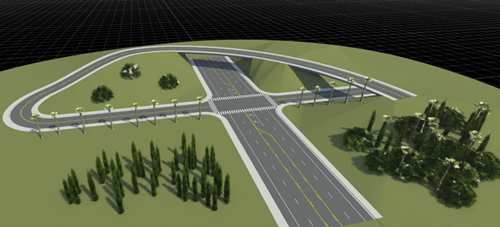
前提条件
在开始此示例之前,请确保您的系统满足以下前提条件:
您已按照安装并激活 RoadRunner中描述的说明下载、安装并激活 RoadRunner。
您拥有 RoadRunner Asset Library 附加组件 的许可证。此示例使用仅在该库中可用的素材。
虽然此示例涵盖了一些基本的相机操作,但为了更全面地了解 RoadRunner 相机的工作原理,请先查看 RoadRunner 中的相机控制 示例。
创建新场景和工程
在 RoadRunner 中,您创建的每个场景都是工程的一部分,该工程是一个素材(场景组件)文件夹,可以在该工程的所有场景之间共享。创建一个新场景和一个放置该场景的新工程。
打开 RoadRunner,然后从开始页面点击 New Scene。
在选择工程窗口中,点击 New Project。
在文件系统中,浏览到要在其中创建工程的空文件夹。如果不存在空文件夹,请创建一个并将其命名
My Project。文件夹名称将成为工程的名称。出现提示时,点击 Yes 在您的工程中安装 RoadRunner Asset Library。
RoadRunner 打开一个新场景,其中有一个空白的场景编辑画布。
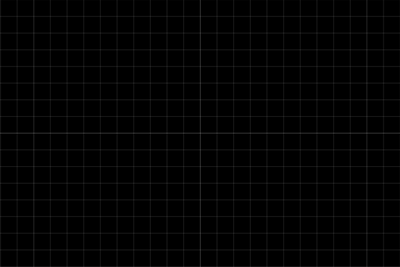
您指定的工程名称出现在标题栏中。场景的名称也会出现在标题栏中,但在您保存场景并命名之前,它会显示为 New Scene。

您可以随时从 File 菜单创建新场景、更改场景或更改工程。当您重新打开 RoadRunner 时,您可以在开始页的最近的场景列表中选择您最近处理的场景。
添加道路
当您打开一个新场景时,RoadRunner 会打开并选定 Road Plan Tool ![]() 。有关使用此工具的说明显示在底部状态栏中。通过在选择此工具的情况下在场景编辑画布中右键点击,您可以添加塑造道路几何形状的控制点。
。有关使用此工具的说明显示在底部状态栏中。通过在选择此工具的情况下在场景编辑画布中右键点击,您可以添加塑造道路几何形状的控制点。
在场景编辑画布的底部中心,右键点击以添加新道路的第一个控制点。
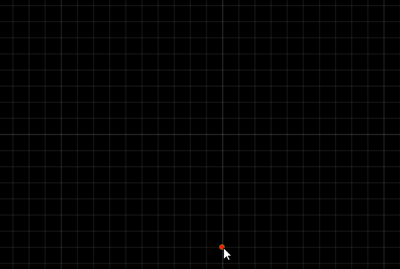
在画布的顶部中心,右键点击以添加第二个控制点并形成第一个路段。
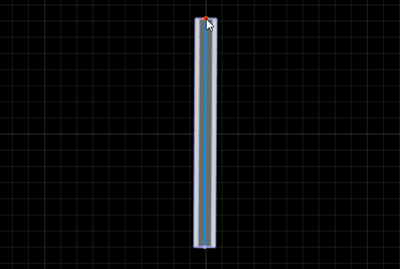
在远离道路的地方点击以取消选择道路并完成创建。
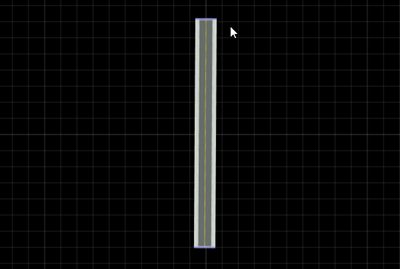
通过右键点击第一条道路的左侧、右键点击其右侧,然后点击远离道路的位置,创建一条与第一条道路相交的新直线道路。两条路形成一个交叉口。
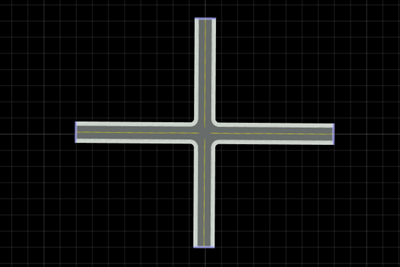
到目前为止,您已经创建了笔直的道路。要形成弯曲道路,请右键点击多次以向道路添加其他控制点。创建一条与交叉路口重叠的弯曲道路。
在交叉路口的左上象限内点击鼠标右键。
在交叉路口的右上象限内右键点击。第一个创建的路段是直的。
右键点击交叉路口的右下象限。交叉路口和弯曲道路围成的区域形成地面。

您可以通过选择道路端点并右键点击添加更多控制点来延伸现有道路。
在您创建的弯曲道路中,点击以选择画布顶部附近的末端。
右键点击交叉路口的左端。RoadRunner 创建一条满足必要几何约束的道路。封闭区域再次形成地面。

要修改任何道路,请点击将其选中,然后尝试拖动其控制点或移动整条道路。您还可以右键点击道路来添加其他控制点。例如,在此道路网络中,您可以添加控制点来平滑交叉路口左侧的曲线。
添加表面地形
到目前为止,只有道路包围的区域包含地表地形。要在整个道路网络周围添加表面地形,您可以使用表面工具 ![]() 。
。
在工具栏中,点击 Surface Tool 按钮。选择一个新工具将使 RoadRunner 处于不同的模式,从而实现新的交互并使不同的场景对象可供选择。选择 Surface Tool 后,道路不再可选,但路面节点变为可选。
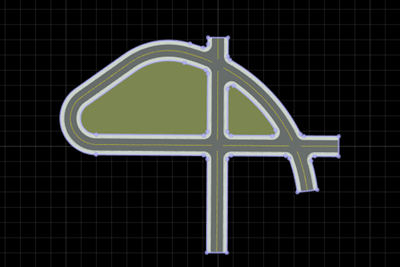
缩小场景,可以使用滚轮或按住 Alt 并右键点击,然后向下或向左拖动。
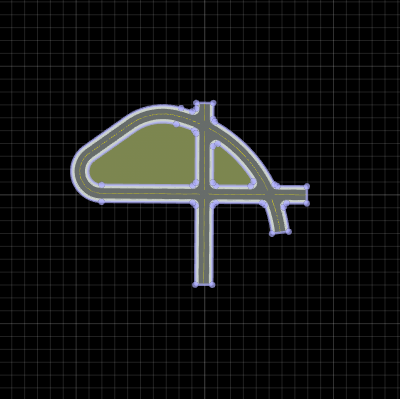
右键点击道路网络上方以添加新的表面节点。然后,继续右键点击道路周围的点以形成一个圆圈。当您再次到达顶部节点时,右键点击它以连接曲面图并将曲面提交到画布。
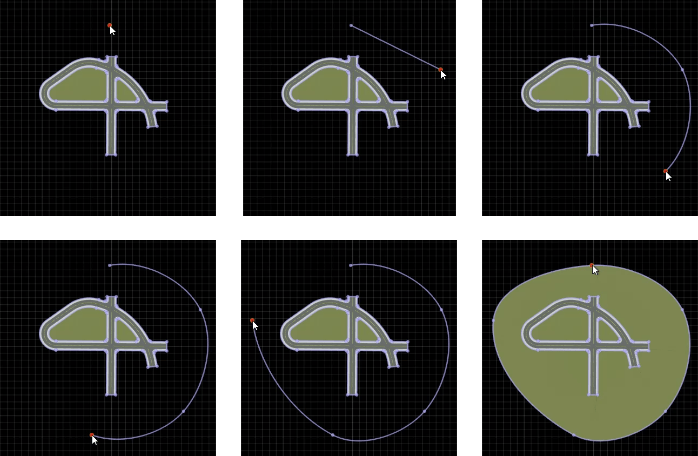
要修改曲面尺寸,请点击并拖动曲面节点。要修改曲面的曲线,请点击节点之间的线段,然后点击并拖动切线。
添加高程和桥梁
至此,场面已经平淡。通过更改其中一条道路的高度来修改场景中的高程。
按住 Alt,然后点击并拖动相机以一定角度查看场景。
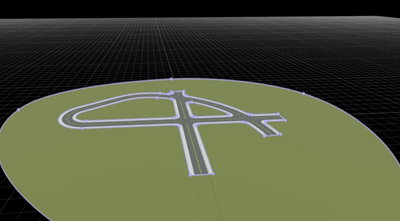
点击 Road Plan Tool 按钮可再次选择道路。然后,点击以选择您创建的第一条弯曲道路。
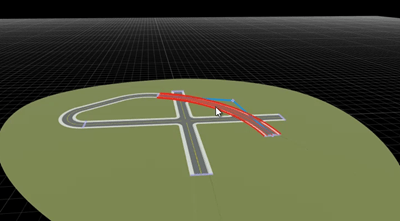
要升高道路,请使用 2D Editor,它可以让您查看道路轮廓和道路横截面等场景方面。在 2D Editor 中,选择道路的轮廓并将其提高约 10 米。

现在,道路在场景画布中的交叉路口上方已升高。高架道路不是形成交叉口,而是形成立交桥。
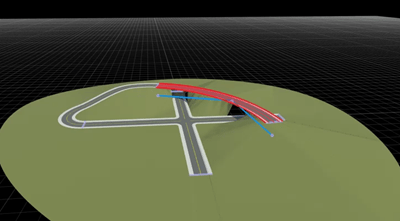
道路依附于地表地形。当您抬高道路时,地形也会随之抬高。增加高程可能会导致立交桥下方出现视觉伪影。为了解决此问题,您可以使用道路构造工具 ![]() 创建桥梁跨度。
创建桥梁跨度。
旋转相机并放大以查看立交桥上的视觉伪影。
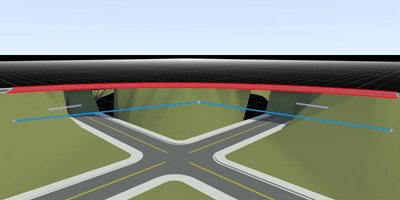
点击 Road Construction Tool 按钮。
在左侧工具栏上,点击 Auto Assign Bridges 按钮
 。此操作仅在使用道路构造工具时可用,它仅将位于区域正上方的道路部分转换为桥梁跨度。使用默认的桥梁跨度膨胀并点击 OK。道路跨度被转换为桥梁,视觉伪影被消除。
。此操作仅在使用道路构造工具时可用,它仅将位于区域正上方的道路部分转换为桥梁跨度。使用默认的桥梁跨度膨胀并点击 OK。道路跨度被转换为桥梁,视觉伪影被消除。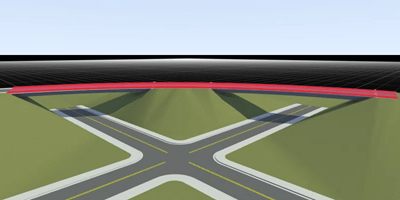
如果桥梁形成不正确,请尝试调整道路高程或桥梁跨度膨胀并重新运行 Auto Assign Bridges 操作。
修改交叉口
某些工具使您能够选择和修改交叉口的属性。修改四路交叉路口的拐角半径。
点击 Corner Tool 按钮
 ,然后点击以选择四路交叉路口。
,然后点击以选择四路交叉路口。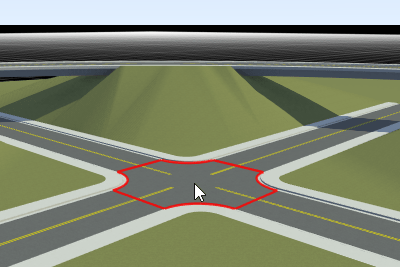
默认情况下,连接点的角半径为
5米。使用 Attributes 窗格增加此值。此窗格包含有关当前所选项目的信息和可编辑属性。在 Corner Tool 中,选择交叉口会选择交叉口的所有四个角,因此您可以同时修改所有四个角的属性。在 Attributes 窗格中,将所有四个角的 Corner Radius 属性设置为
10。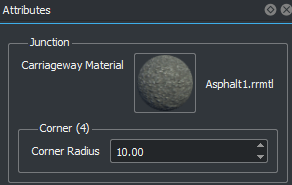
交叉口拐角在场景编辑画布中展开。
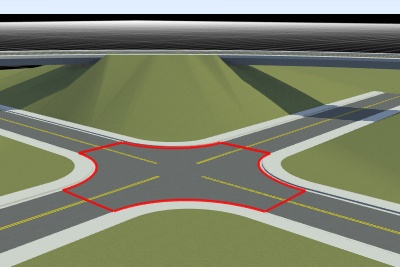
或者,您可以通过点击属性名称  并向上或向下拖动来修改 Corner Radius 属性值。
并向上或向下拖动来修改 Corner Radius 属性值。
添加人行横道
在交叉路口添加人行横道。
旋转相机从上到下查看交叉路口。要将相机聚焦于选定的交叉路口,请按 F 键。
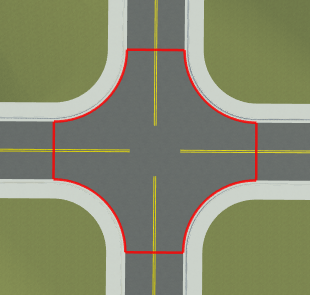
点击 Crosswalk and Stop Line Tool 按钮
 。交叉路口显示蓝色 V 形,用于向交叉路口添加停止线。
。交叉路口显示蓝色 V 形,用于向交叉路口添加停止线。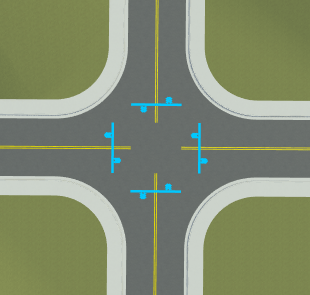
从 Library Browser 中,选择一个人行横道添加到交叉路口。Library Browser 存储了可添加到场景的所有素材。素材包括三维对象、标记、纹理和材质。
在 Library Browser 中,选择
Markings文件夹,然后选择ContinentalCrosswalk素材。素材预览显示在素材查看器中。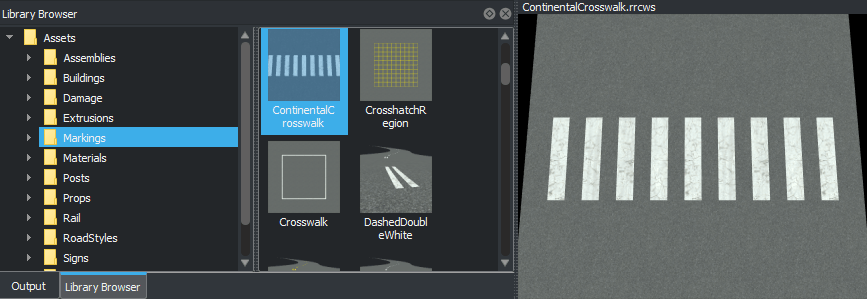
在交叉路口内点击以清除蓝色 V 形。然后,右键点击交叉路口以将选定的人行横道素材应用到交叉路口。
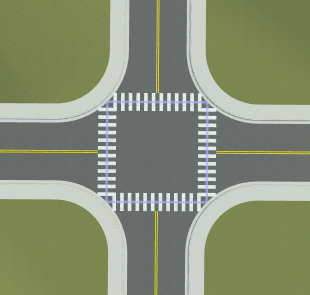
添加转弯车道
将交叉路口的其中一条道路转换为更复杂的高速公路,其中包括带箭头标记的转弯车道。
改变道路风格
现有道路均采用默认道路样式,为简单的两车道分立式高速公路,设有人行道。更新交叉路口的其中一条道路以使用带有额外车道的道路样式。
缩小并旋转相机,以类似于此处所示的角度查看场景。
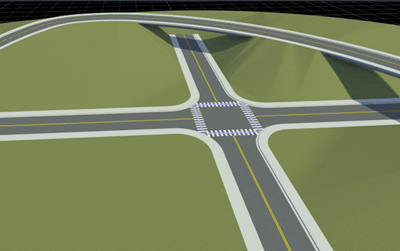
在 Library Browser 中,打开
RoadStyles文件夹,然后选择MainStreetCenterTurn素材。该道路样式素材包括路肩车道、每侧两条超车道和一条中间车道。(可选)在素材查看器中旋转和移动相机以检查道路样式。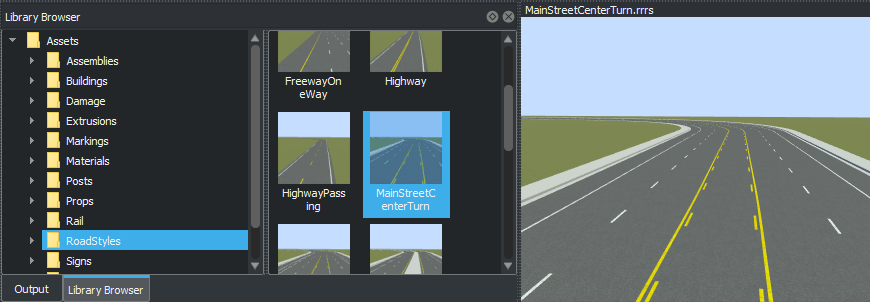
将选定的道路样式拖到最靠近相机的道路上,如下所示。道路更新为新样式并切换回道路规划工具。道路保持先前应用的拐角半径和人行横道样式。

在交叉路口创建转弯车道
在交叉路口附近创建一条短的左转车道。
旋转相机并放大具有新道路样式的道路一侧的人行横道附近。
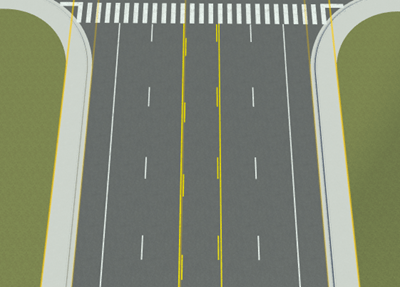
点击 Lane Carve Tool 按钮
 。此工具使您能够在现有车道中创建锥形切口以形成转弯车道。
。此工具使您能够在现有车道中创建锥形切口以形成转弯车道。点击以选择道路。然后,右键点击中间车道右侧要开始逐渐变细的位置。将蓝线对角拖动到中间车道的左侧,您希望在此结束锥形切口并开始转弯车道。

新形成的转弯车道仍保留中间车道的风格。更新车道标记以匹配标准转弯车道的样式。
在 Library Browser 中,选择
SolidSingleWhite素材并将其拖到转弯车道的右侧。车道标记变为单白实线。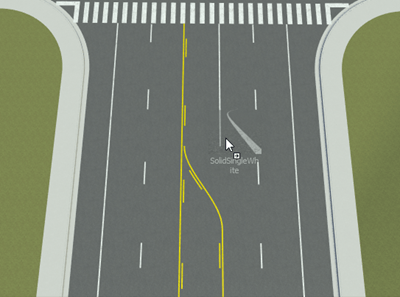
选择
SolidDoubleYellow素材并将其拖动到形成转弯车道左侧的两个标记段上。车道标记线段变为双黄实线。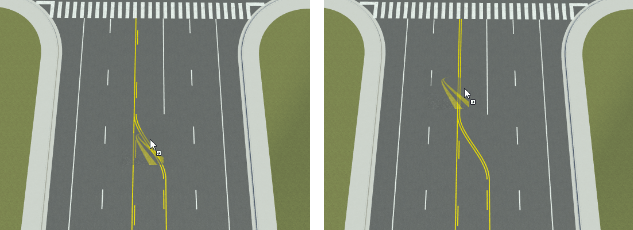
在车道上添加一个转向箭头。在 Library Browser 的
Stencils文件夹中,选择Stencil_ArrowType4L素材。将此素材拖动到转弯车道中要添加箭头模具的位置。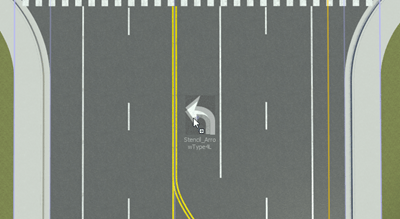
通过添加箭头模板,RoadRunner 选择点标记工具
 使其成为活动工具。现在,您可以通过右键点击要添加第二个箭头的位置来添加它。
使其成为活动工具。现在,您可以通过右键点击要添加第二个箭头的位置来添加它。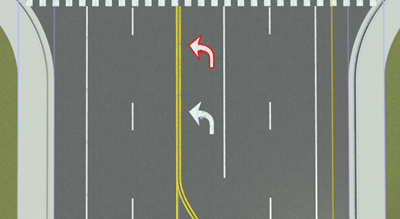
修改箭头的标记材质,使它们看起来更磨损。首先,选择两个箭头。在 Library Browser 的
Markings文件夹中,选择LaneMarking2材质素材。然后,将该素材拖到所选箭头的 Attributes 窗格中,并覆盖现有的LaneMarking1材质素材。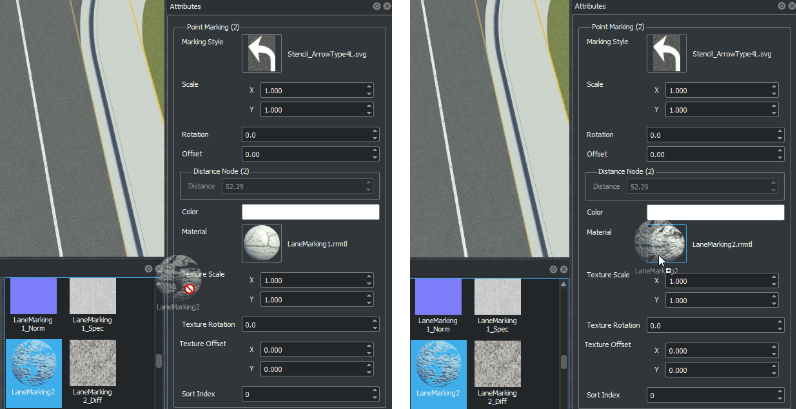
箭头更新为使用看起来更磨损的新材质。
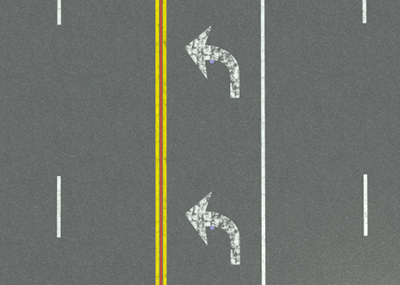
重复这些步骤以在交叉路口的另一侧创建转弯车道。
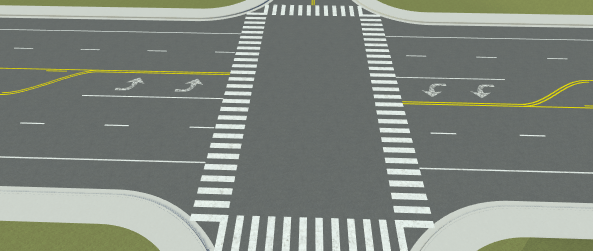
添加道具
为了增强场景的细节,请添加道具。道具是可放置在道路上和周围的三维物体,例如支柱、电线杆和标志。使用多种技术在道路周围添加树木道具。
添加单独的道具
将灌木丛添加到地形的一部分。
缩小并旋转相机以适应整个道路网络和周围地形的视野。
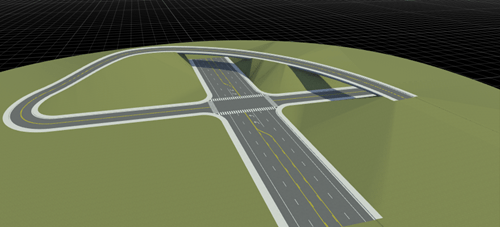
在 Library Browser 中,打开
Props文件夹并选择Trees子文件夹。选择灌木丛道具(以
Bush_开头的素材文件之一)。将灌木丛拖到场景的一部分上。RoadRunner 切换到点道具工具 。将其他灌木拖到场景中或右键点击以添加更多灌木。所有灌木丛均与地表地形对齐。
。将其他灌木拖到场景中或右键点击以添加更多灌木。所有灌木丛均与地表地形对齐。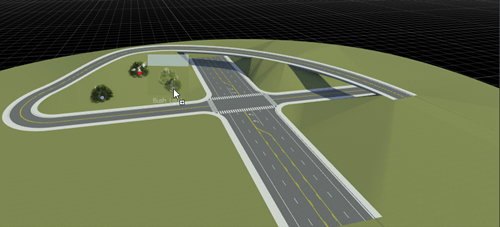
沿曲线添加道具
沿着曲线添加道具以遵循道路边缘。
点击 Prop Curve Tool 按钮
 。
。在 Library Browser 的
Trees文件夹中,选择加州棕榈树道具(以CalPalm_开头的素材文件之一)。沿着交叉路口一侧的道路边缘右键点击,为其添加一行棕榈树。在远离曲线道具的地方点击以完成线条。
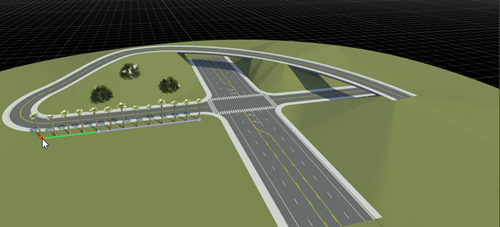
为了使跨度中的每棵树都可以移动和选择,您可以将曲线转换为单独的道具。选择曲线道具,然后在 Attributes 窗格中点击 Bake。棕榈树成为单独的道具,并且 RoadRunner 切换到点道具工具。将一些棕榈树移到交叉路口的另一侧。
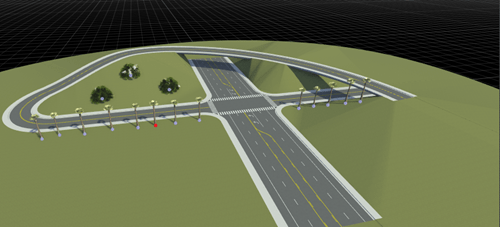
或者,要沿着道路跨度添加道具,您可以点击 Prop Span Tool 按钮 ![]() ,选择一条道路,然后将道具拖到道路边缘上。
,选择一条道路,然后将道具拖到道路边缘上。
在指定区域添加道具
在地面的指定区域添加道具。
点击 Prop Polygon Tool 按钮
 。
。在 Library Browser 的
Trees文件夹中,选择一个柏树道具(以Cypress_开头的素材文件之一)。右键点击地表地形的空白区域以绘制包含所选道具的多边形。点击远离多边形的位置以完成绘制。然后移动点或切线来改变多边形的形状。
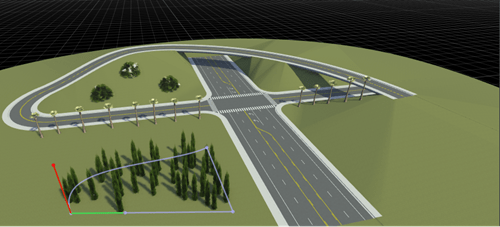
或者,使用 Attributes 窗格中的属性修改多边形道具。例如,要增加或减少多边形中的道具数量,请使用 Density 属性。要随机化多边形中的素材分布,请点击 Randomize。
添加不同类型的道具
到目前为止,您已经向场景添加了一种类型的道具。要同时向场景添加多种道具,您可以创建道具集。
在 Library Browser 的
Trees文件夹中,按住 Ctrl 并选择您在前面部分添加到场景中的三个道具。选择 New,然后选择 Prop Set,并为道具集命名。新的道具组存储在
Trees文件夹中。Attributes 窗格显示该套装中的三个道具和该道具集的预览。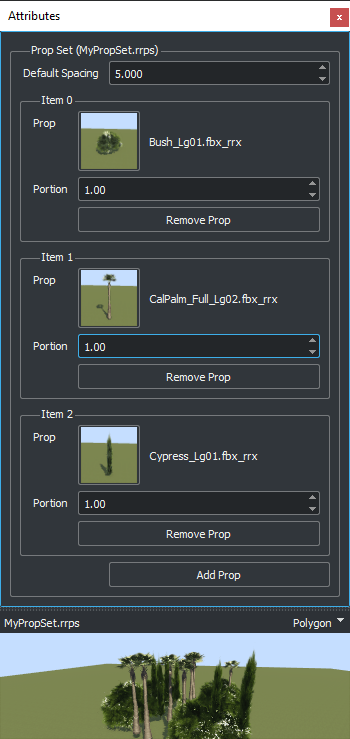
点击 Prop Polygon Tool 按钮。在包含新道具集的地形空白部分创建多边形道具。
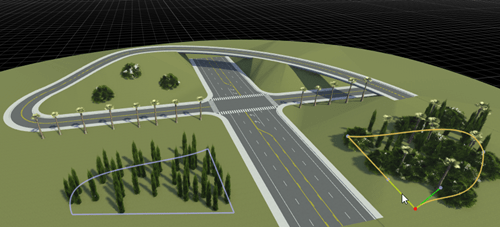
或者,您还可以通过将道具集拖动到柏树的多边形上,将现有的柏树道具替换为新的道具集。
其他值得尝试的事情
您现在已经创建了一个简单的道路网络,其中包含真实的转弯车道、多个立交桥和不同类型的树木。

您现在可以使用其他工具增强场景。例如,尝试以下操作:
此外,您可以尝试将场景导出为支持的导出格式之一。这些导出选项位于 File 菜单上的 Export 下。要在导出之前自定义导出选项,请使用场景导出预览工具。如果要导出到 ASAM OpenDRIVE®,请使用 OpenDRIVE 导出预览工具。此图显示了点击 OpenDRIVE Export Preview Tool 按钮 ![]() 时所创建的场景的导出预览。
时所创建的场景的导出预览。
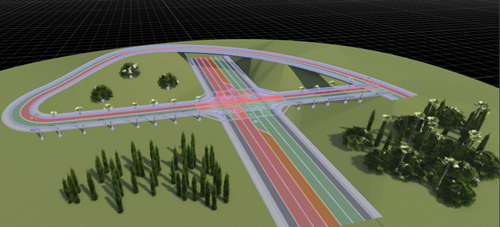
如果您想创建一个基于真实世界位置的新场景,那么您可以将地理信息系统 (GIS) 数据(例如航拍图像)导入 RoadRunner 并围绕它创建场景。有关示例,请参阅围绕导入的 GIS 素材创建道路。